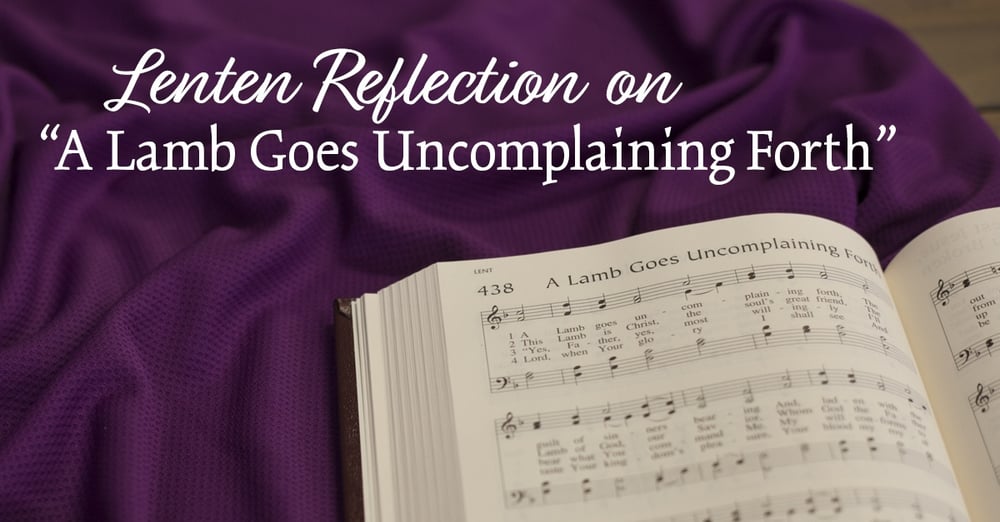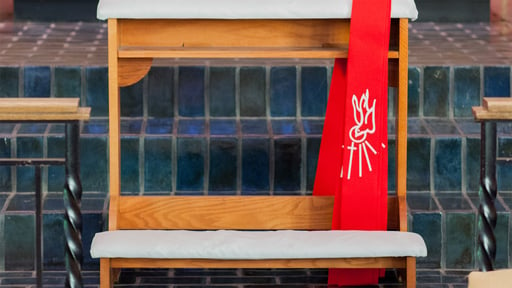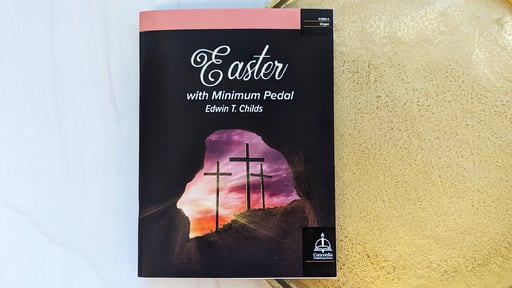As the recently arrived Lent spurs Christians to reflect on their mortality and sinfulness, to give up vices, and to contemplate the suffering of Christ, we begin looking forward with great eagerness to Easter. While Lent may be a beautiful and necessary part of the Church Year, the solemnity of this time can sometimes turn discouraging. This year, I have turned to Paul Gerhardt’s text of “A Lamb Goes Uncomplaining Forth” (LSB 438) to seek comfort, assurance, and confidence in the hope of the resurrection.
“All This I Gladly Suffer”
A Lamb goes uncomplaining forth,
The guilt of sinners bearing
And, laden with the sins of earth,
None else the burden sharing;
Goes patient on, grows weak and faint,
To slaughter led without complaint,
That spotless life to offer,
He bears the stripes, the wounds, the lies,
The mockery, and yet replies,
“All this I gladly suffer.”
(LSB 438:1)
Gerhardt immediately offers the picture of a lamb, the most weak and innocent of creatures. Unlike the dumb and unintelligent animals we see here on earth, however, this Lamb possesses full knowledge of His work and course in life. He is no clueless creature, but rather is certain of what is happening to Him and the way it will end.
And yet, He goes to slaughter “without complaint.” This weak, innocent creature fully realizes His suffering under the weight of His load of the “guilt of sinners” and “the sins of earth” and yet utters not one word of protest. He bears both physical and mental abuse, but this Lamb agrees not only to suffer those things but to do it gladly. The words of stanza 1, then, present the focus of the entire hymn: not the sinner, but the Lamb. The Lamb who wildly and irrationally, or so it seems, suffers for others with gladness.
“The Soul’s Great Friend”
This Lamb is Christ, the soul’s great friend,
The Lamb of God, our Savior,
Whom God the Father chose to send
To gain for us His favor.
“Go forth, My Son,” the Father said,
“And free My children from their dread
Of guilt and condemnation.
The wrath and stripes are hard to bear,
But by Your passion they will share
The fruit of Your salvation.”
(LSB 438:2)
In stanza 2, Gerhardt confirms that the Lamb is indeed Christ, who is not merely an emotionless tool used by the Father to accomplish a task but is the “soul’s great friend,” who has entered into a relationship with us, the Father’s children. The Father sent His perfect Son to save the rest of His sons and daughters who suffer the “dread of guilt and condemnation.”
It is only through this perfect Son, the Lamb of God, Christ, that the sinful children of God gain salvation. Again, Christ, not the sinner, is the focus of the text. And it is through Christ’s Passion, His suffering with gladness out of great love for the sinner, that we share in the “fruit of [His] salvation.”
“Most Willingly”
“Yes, Father, yes, most willingly
I’ll bear what You command Me.
My will conforms to Your decree,
I’ll do what You have asked Me.”
O wondrous Love, what have You done!
The Father offers up His Son,
Desiring our salvation.
O Love, how strong You are to save!
You lay the One into the grave
Who built the earth’s foundation.
(LSB 438:3)
Christ answers the Father with eagerness in stanza 3. He does not merely acquiesce out of a sense of obligation, but “most willingly” does what has been commanded of Him. It is His great love for us, not a dull resignation to duty, that drives Him to earth to be our Savior.
And Gerhardt beautifully pens our response: a great cry of shock at this display of love. How could the creator of the universe, the layer of the foundation of the world, suffer even death for us? But, as the text reminds us, it has been done. The use of past tense in “what have You done” and “You lay the One into the grave” shows us that the deed has been accomplished. The use of the present tense in “the Father offers up His Son, Desiring our salvation” shows us that the Father continues to desire our salvation. He continues to offer us His Son in the bread and wine of Holy Communion. And this continues to be done “most willingly.”
“To Stand in Joy beside You”
Lord, when Your glory I shall see
And taste Your kingdom’s pleasure,
Your blood my royal robe shall be,
My joy beyond all measure!
When I appear before Your throne,
Your righteousness shall be my crown;
With these I need not hide me.
And there, in garments richly wrought,
As Your own bride shall we be brought
To stand in joy beside You.
(LSB 438:4)
The final stanza offers comfort not only in its picture of heaven, but also in Gerhardt’s use of confident wording. It is “when Your glory I shall see,” not “if Your glory I might see.” It is “Your blood my royal robe shall be,” not “might be.” It is “when I appear before Your throne,” not “if I appear.” Gerhardt’s words should be our own: words of confidence not in ourselves but in the sacrifice of the Lamb. After all, it is “Your blood my royal robe shall be” and “Your righteousness shall be my crown.”
Finally, this concluding stanza contains a word that at first glance seems highly unusual for Lent: “joy.” Joy not in ourselves, though. After all, we have only a “dread of guilt and condemnation.” No, this joy is in the saving work of Christ, a work we remember and celebrate during Lent. And we can celebrate as we look toward the empty tomb and, finally, to the day when we can “stand in joy” beside our Lord.
Gerhardt’s text beautifully encapsulates the confidence and joy we have through Christ. The hymn reminds us that while Lent is a time to reflect on our sinfulness and mortality, this reflection points us toward the saving work of Christ’s suffering and death. Christ is the focus. And one day we will stand in joy beside Him because He has not only suffered and died but risen again.

Hymn text: © 1941 CPH.





.jpg?width=50&height=50&name=IMG_20220621_160541_456%20(1).jpg)








